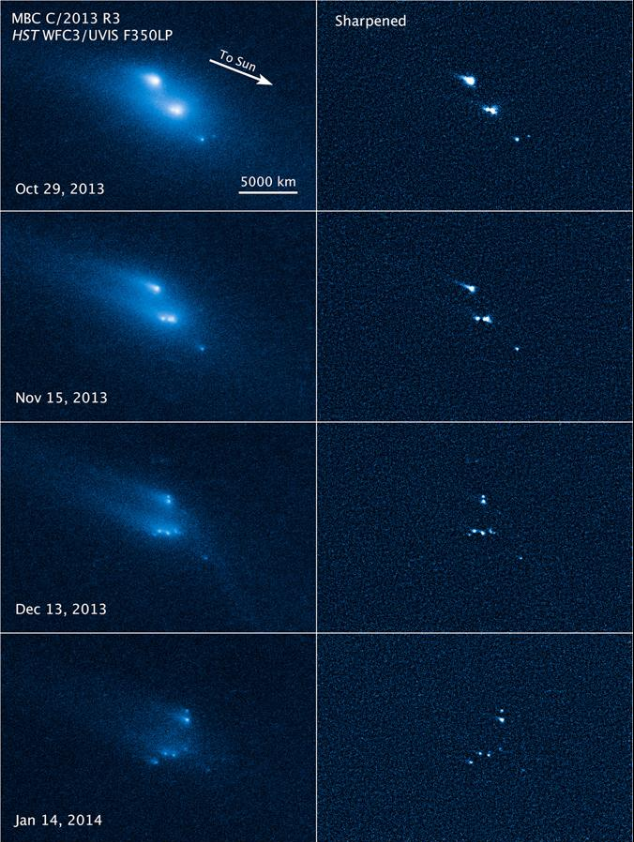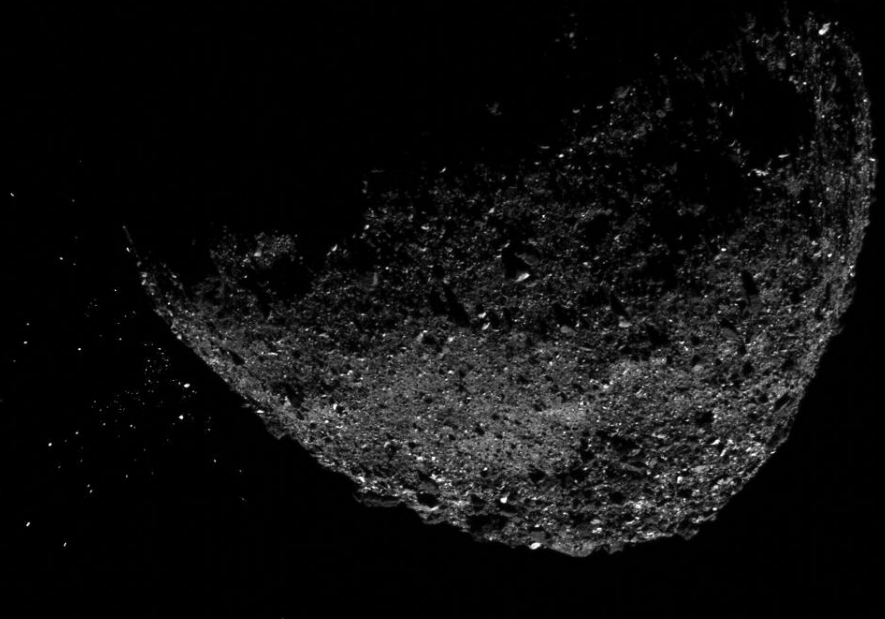
| Version | Summary | Created by | Modification | Content Size | Created at | Operation |
|---|---|---|---|---|---|---|
| 1 | Camila Xu | -- | 1246 | 2022-10-19 01:49:28 |
Video Upload Options
User:RMCD bot/subject notice Main-belt comets (MBCs) are bodies orbiting within the asteroid belt that have shown comet-like activity during part of their orbit. The Jet Propulsion Laboratory defines a main-belt asteroid as an asteroid with a semi-major axis (average distance from the Sun) of more than 2 AU but less than 3.2 AU, and a perihelion (closest approach distance to the Sun) of no less than 1.6 AU. David Jewitt from UCLA points out that these objects are most likely not comets with sublimating ice, but asteroids that exhibit dust activity, and hence he and others started calling these class of objects active asteroids. The first main-belt comet discovered is 7968 Elst–Pizarro. It was discovered in 1979 and was found to have a tail by Eric Elst and Guido Pizarro in 1996 and given the cometary designation 133P/Elst-Pizarro.
1. Orbits

Unlike comets, which spend most of their orbit at Jupiter-like or greater distances from the Sun, main-belt comets follow near-circular orbits within the asteroid belt that are undistinguishable from the orbits of many standard asteroids. Although quite a few short-period comets have semimajor axes well within Jupiter's orbit, main-belt comets differ in having small eccentricities and inclinations similar to main-belt asteroids. The first three identified main-belt comets all orbit within the outer part of the asteroid belt.[2]
It is not known how an outer Solar System body like the other comets could have made its way into a low-eccentricity orbit typical of the asteroid belt, which is only weakly perturbed by the planets. Hence it is assumed that unlike other comets, the main-belt comets are simply icy asteroids, which formed in an inner Solar System orbit close to their present positions, and that many outer asteroids may be icy.[2]
2. Activity
Some main-belt comets display a cometary dust tail only for a part of their orbit near perihelion. This strongly suggests that volatiles at their surfaces are sublimating, driving off the dust.[3] Activity in 133P/Elst–Pizarro is recurrent, having been observed at each of the last three perihelia.[4] The activity persists for a month or several[2] out of each 5-6 year orbit, and is presumably due to ice being uncovered by minor impacts in the last 100 to 1000 years.[2] These impacts are suspected to excavate these subsurface pockets of volatile material helping to expose them to solar radiation.[2]
When discovered in January 2010, P/2010 A2 (LINEAR) was initially given a cometary designation and considered a member of this group,[5] but P/2010 A2 is now thought to be the remnant of an asteroid-on-asteroid impact.[6][7] Observations of (596) Scheila indicated that large amounts of dust were kicked up by the impact of another asteroid of approximately 35 meters in diameter.
2.1. P/2013 R3

In October 2013, observations of P/2013 R3, taken with the 10.4 m Gran Telescopio Canarias on the island of La Palma, showed that this comet was breaking apart.[9] Inspection of the stacked CCD images obtained on October 11 and 12 showed that the main-belt comet presented a central bright condensation that was accompanied on its movement by three more fragments, A,B,C. The brightest A fragment was also detected at the reported position in CCD images obtained at the 1.52 m telescope of the Sierra Nevada Observatory in Granada on October 12.[9]
NASA reported on a series of images taken by the Hubble Space Telescope between October 29, 2013 and January 14, 2014 that show the increasing separation of the four main bodies.[10] The Yarkovsky–O'Keefe–Radzievskii–Paddack effect, caused by sunlight, increased the spin rate until the centrifugal force caused the rubble pile to separate.[10]
3. Composition
It has been hypothesized that main-belt comets may have been the source of Earth's water, because the deuterium–hydrogen ratio of Earth's oceans is too low for classical comets to have been the principal source.[11] European scientists have proposed a sample-return mission from a MBC called Caroline to analyse the content of volatiles and collect dust samples.[3]
4. Members
The term 'main-belt comet' is a classification based on orbit and the presence of an extended morphology. It does not imply that these objects are comets or that the material surrounding their nuclei was ejected by the sublimation of volatiles, as on comets.
Identified members of this morphology class include:
| Full Name | Hsieh[2] | Jewitt[4] | Semi-major axis (a) | Perihelion (q) | Perihelion date | Cause |
|---|---|---|---|---|---|---|
| 133P/Elst–Pizarro (7968 Elst–Pizarro, P/1996 N2) | Y | Y | 3.15 | 2.64 | 2013-02-09 | Impact/Cometary composition |
| 176P/LINEAR (118401 LINEAR) | Y | Y | 3.19 | 2.57 | 2011-07-01 | Impact/Cometary composition |
| 233P/La Sagra (P/2005 JR71) | N | N | 3.04 | 1.79 | 2010-03-12 | Impact/Cometary composition |
| 238P/Read (P/2005 U1) | Y | Y | 3.16 | 2.36 | 2011-03-11 | Impact/Cometary composition |
| 259P/Garradd (P/2008 R1) | Y | Y | 2.72 | 1.79 | 2013-01-25 | Orbit change |
| 288P ((300163) 2006 VW139) | Y | Y | 3.05 | 2.44 | 2011-07-18 | Cometary Composition |
| 311P/PANSTARRS (P/2013 P5) | N | Y | 2.19 | 1.95 | 2014-04-16 | Rubble pile disintegration |
| 313P/Gibbs (P/2003 S10) | N/A | Y | 3.16 | 2.39 | 2014-08-28 | Cometary composition |
| 324P/La Sagra (P/2010 R2) | Y | Y | 3.10 | 2.62 | 2015-11-30 | Impact/cometary composition |
| 331P/Gibbs (P/2012 F5) | N | Y | 3.00 | 2.88 | 2010-03-26 | Rubble pile disintegration |
| 348P/PANSTARRS (P/2011 A5) | N/A | N | 3.17 | 2.21 | 2016-06-21 | ? |
| 354P/LINEAR (P/2010 A2) | N | Y | 2.29 | 2.00 | 2013-05-23 | Impact |
| 358P/PANSTARRS (P/2012 T1) | Y | Y | 3.15 | 2.41 | 2012-09-10 | Impact/cometary composition |
| 367P/Catalina (P/2011 CR42) | N/A | N | 3.51 | 2.53 | 2011-11-29 | ? |
| P/2013 R3-A (Catalina-PANSTARRS) | Y | Y | 3.03 | 2.20 | 2013-08-05 | Rubble pile disintegration |
| P/2013 R3-B (Catalina-PANSTARRS) | Y | Y | 3.03 | 2.20 | 2013-08-05 | Rubble pile disintegration |
| P/2014 C1 (TOTAS) | N/A | N | 3.04 | 1.69 | 2013-12-18 | ? |
| P/2015 X6 (PANSTARRS) | N/A | Y | 2.75 | 2.29 | 2016-03-18 | Rubble pile disintegration or cometary composition |
| P/2016 G1 (PANSTARRS) | N/A | Y | 2.58 | 2.04 | 2017-01-26 | Impact |
| P/2016 J1-A (PANSTARRS) | N/A | Y | 3.17 | 2.45 | 2016-06-24 | Impact/Cometary composition/Rubble pile disintegration |
| P/2016 J1-B (PANSTARRS) | N/A | Y | 3.17 | 2.45 | 2016-06-24 | Impact/Cometary composition/Rubble pile disintegration |
| P/2016 P1 (PANSTARRS) | N/A | N | 3.23 | 2.28 | 2015-09-07 | ? |
| P/2017 S5 (ATLAS) | N/A | N/A | 3.17 | 2.18 | 2017-07-27 | ? |
| P/2017 S8 (PANSTARRS) | N/A | N/A | 2.78 | 1.68 | 2018-01-28 | ? |
| P/2017 S9 (PANSTARRS) | N/A | N/A | 3.16 | 2.20 | 2017-07-23 | ? |
| P/2018 P3 (PANSTARRS) | N/A | N/A | 3.01 | 1.76 | 2018-10-09 | ? |
| P/2019 A3 (PANSTARRS) | N/A | N/A | 3.15 | 2.31 | 2018-08-01 | ? |
| P/2019 A4 (PANSTARRS) | N/A | N/A | 2.61 | 2.36 | 2018-11-28 | ? |
| P/2019 A7 (PANSTARRS) | N/A | N/A | 3.19 | 2.68 | 2018-01-08 | ? |
| 493 Griseldis | N | N | 3.12 | 2.57 | 2019-02-15 | Impact |
| 596 Scheila | N | Y | 2.92 | 2.44 | 2012-05-19 | Impact |
| 6478 Gault | N | N | 2.31 | 1.86 | 2020-01-02 | Impact |
| (62412) 2000 SY178 | N | Y | 3.15 | 2.90 | 2018-10-29 | Rubble pile disintegration |
| 101955 Bennu | N/A | N/A | 1.13 | 0.90 | 2010-08-30 | Thermal fracturing, volatile release, and/or impacts[12] |
5. Exploration

Castalia is a proposed mission concept for a robotic spacecraft to explore 133P/Elst–Pizarro and make the first in situ measurements of water in the asteroid belt, and thus, help solve the mystery of the origin of Earth's water.[13] The lead is Colin Snodgrass, from The Open University in the UK. Castalia was proposed in 2015 and 2016 to the European Space Agency within the Cosmic Vision programme missions M4 and M5, but it was not selected. The team continues to mature the mission concept and science objectives.[13] Because of the construction time required and orbital dynamics, a launch date of October 2028 was proposed.[13]
On January 6, 2019, the OSIRIS-REx mission first observed episodes of particle ejection from 101955 Bennu shortly after entering orbit around the near-Earth asteroid, leading it to be newly classified as an active asteroid. The scale of these observed mass loss events is much smaller than those previously observed at other active asteroids by telescopes, indicating that there is a continuum of mass loss event magnitudes at active asteroids.[12]
References
- Harrington, J.D.; Villard, Ray (6 March 2014). "RELEASE 14-060 NASA's Hubble Telescope Witnesses Asteroid's Mysterious Disintegration". NASA. http://www.nasa.gov/press/2014/march/nasas-hubble-telescope-witnesses-asteroids-mysterious-disintegration-1. Retrieved 6 March 2014.
- Henry H. Hsieh (May 2010). "Main Belt Comets". Hawaii. http://www.ifa.hawaii.edu/~hsieh/mbcs.shtml. Retrieved 2010-12-15. (older 2010 site)
- The proposed Caroline ESA M3 mission to a Main Belt Comet. Geraint H. Jones, Jessica Agarwal, Neil Bowles, Mark Burchell, Andrew J. Coates, Alan Fitzsimmons, Amara Graps, Henry H. Hsieh, Carey M. Lisse, Stephen C. Lowry, Adam Masters, Colin Snodgrass, Cecilia Tubiana. Advances in Space Research. 25 February 2018. doi:10.1016/j.asr.2018.02.032 https://ac.els-cdn.com/S0273117718301741/1-s2.0-S0273117718301741-main.pdf?_tid=60729ad6-8e38-4774-a5a4-cb1535560808&acdnat=1523207512_194ea87998b5bd4a360bee5af6739f73
- David Jewitt. "Main Belt Comets". UCLA, Department of Earth and Space Sciences. http://www2.ess.ucla.edu/~jewitt/mbc.html. Retrieved 2010-12-15.
- MPEC 2010-A51 : COMET P/2010 A2 (LINEAR) http://www.minorplanetcenter.org/mpec/K10/K10A51.html
- Jewitt, David; Weaver, Harold; Agarwal, Jessica; Mutchler, Max; Drahus, Michal (2010). "A recent disruption of the main-belt asteroid P/2010?A2". Nature 467 (7317): 817–9. doi:10.1038/nature09456. PMID 20944743. Bibcode: 2010Natur.467..817J. https://dx.doi.org/10.1038%2Fnature09456
- Snodgrass, Colin; Tubiana, Cecilia; Vincent, Jean-Baptiste; Sierks, Holger; Hviid, Stubbe; Moissl, Richard; Boehnhardt, Hermann; Barbieri, Cesare et al. (2010). "A collision in 2009 as the origin of the debris trail of asteroid P/2010?A2". Nature 467 (7317): 814–6. doi:10.1038/nature09453. PMID 20944742. Bibcode: 2010Natur.467..814S. https://dx.doi.org/10.1038%2Fnature09453
- "Hubble witnesses an asteroid mysteriously disintegrating". ESA / HUBBLE. http://www.spacetelescope.org/news/heic1405/. Retrieved 12 March 2014.
- Licandro, Javier. "Main Belt Comet P/2013 R3 is breaking apart". IAC Press Release. http://www.iac.es/divulgacion.php?op1=16&id=816&lang=en&img=1051. Retrieved 17 October 2013.
- https://science.nasa.gov/science-news/science-at-nasa/2014/06mar_asteroid/
- Main-Belt Comets May Have Been Source Of Earths Water, Space Daily, Mar 23, (2006). http://www.spacedaily.com/reports/Main_Belt_Comets_May_Have_Been_Source_Of_Earths_Water.html
- Lauretta, D. S.; Hergenrother, C. W.; Chesley, S. R.; Leonard, J. M.; Pelgrift, J. Y. et al. (6 Dec 2019). "Episodes of particle ejection from the surface of the active asteroid (101955) Bennu". Science 366 (6470). doi:10.1126/science.aay3544. https://science.sciencemag.org/content/366/6470/eaay3544.
- Snodgrass, C.; Jones, G.H.; Boehnhardt, H.; Gibbings, A.; Homeister, M.; Andre, N.; Beck, P.; Bentley, M.S. et al. (2018). "The Castalia mission to Main Belt Comet 133P/Elst-Pizarro". Advances in Space Research 62 (8): 1947–1976. doi:10.1016/j.asr.2017.09.011. Bibcode: 2018AdSpR..62.1947S. https://dx.doi.org/10.1016%2Fj.asr.2017.09.011




